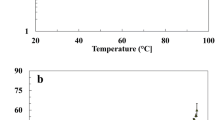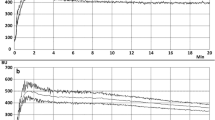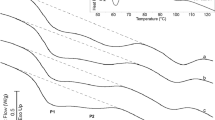Abstract
The effect of maize resistant starch (MRS) and transglutaminase (TG) on rheological and thermal properties of pan bread dough was studied. The MRS was added as an alternative to increase the fiber ingestion while TG supplies the gluten dilution, catalyzing protein bonds. A second order central composite design (22) with three central and four star points was applied, and the results were compared to those of pan bread dough prepared without MRS and TG, as control. The presence of MRS and TG significantly (P < 0.05) influenced the maximum resistance to extension achieving the highest value for the dough formulated with 8.8 g/100 g of MRS and 0.12 g/100 g of TG. A modified power-law model was fitted to the stress–strain data obtained from biaxial test, indicating that partial substitution of wheat flour by MRS resulted high n index (degree of strain hardening). Only starch gelatinization enthalpy significantly changed (P < 0.05) by MRS and TG contents, increasing with the increase of TG. The temperatures obtained from thermograms are compared to those obtained from DSC curves from aqueous suspensions of MRS, indicating gelatinization temperatures above 100 °C.


Similar content being viewed by others
References
AACC. (2000). Approved methods of the American Association of Cereal Chemists (10th edition). American Association of Cereal Chemists. Minnesota, USA: Saint Paul.
Armero, E., & Collar, C. (1997). Texture properties of formulated doughs. Relantionships with dough and bread technological quality. Zeitschrift für Lebensmitteluntersuchung und -Forschung A, 204, 136–145.
Baixauli, R., Sanz, T., Salvador, A., & Fiszman, S. M. (2008). Muffins with resistant starch: baking performance in relation to the rheological properties of the batter. Journal of Cereal Science, 47, 502–509.
Basman, A., Köksel, H., & NG, P. K. W. (2002). Effects of increasing levels of transglutaminase on the rheological properties and bread quality characteristics of two wheat flours. European Food Research and Technology, 215, 419–424.
Brown, I. L. (2004). Applications and uses of resistant starch. Journal of AOAC International, 87, 727–732.
Chin, N. L., & Campbell, G. M. (2005). Dough aeration and rheology: Part 2. Effects of flour type, mixing speed and total work imput on aeration and rheology of bread dough. Journal of the Science Food and Agriculture, 85, 2194–2202.
Collar, C., & Bolláin, C. (2004). Impact of microbial transglutaminase on the viscoelastic profile of formulated bread doughs. European Food Research and Technology, 218, 139–146.
Costa, M. G., Souza, E. L., Stamford, T. L. M., & Andrade, S. A. C. (2008). Technological quality of national and imported wheat grain and wheat flours. Ciência e Tecnologia de Alimentos, 28(1), 220–225.
Ćurić, D., Karlović, D., Tušak, D., Petrović, B., & Ðugum, J. (2001). Gluten as a standard of wheat flour quality. Food Technology and Biotechnology, 39, 353–361.
Dobraszczyk, B. J., & Roberts, C. A. (1994). Strain hardening and dough gas cell-wall failure in biaxial extension. Journal of Cereal Science, 20, 265–274.
Dobraszczyk, B. J., Somewing, J., Albertini, M., Maesmann, G., & Schofield, J. D. (2003). Extensional rheology and stability of gas cell walls in bread dough at elevated temperatures in relation to breadmaking performance. Cereal Chemistry, 80, 218–224.
Dunnewind, B., Sliwinski, E. L., Grolle, K., & van Vliet, T. (2004). The kieffer dough and gluten extensibility rig – an experimental evaluation. Journal of Texture Studies, 34, 537–560.
Eerlingen, R. C., & Delcour, J. A. (1995). Formation, analysis, structure and properties of type III enzyme resistant starch. Journal of Cereal Science, 22, 129–138.
Englyst, H. N., & Cummings, J. H. (1987). Resistant starch, a new food component: a classification of starch for nutritional purposes. In J. D. Morton (Ed.), Cereals in a European Context. First European Conference on Food Science and Technology (pp. 221–233). Chichester, UK: Ellis Horwood.
Englyst, K. N., Liu, S., & Englyst, H. N. (2007). Nutritional characterization and measurement of dietary carbohydrates. European Journal of Clinical Nutrition, 61(S1), 519–539.
Fuentes-Zaragoza, E., Riquelme-Navarrete, M. J., Sánchez-Zapata, J. A., & Pérez-Álvarez, J. A. (2010). Resistant starch as functional ingredient: a review. Food Research International, 43, 931–942.
Gelencsér, T., Juhász, R., Hódsági, M., Gergely, S. Z., & Salgó, A. (2008). Comparative study of native and resistant starches. Acta Alimentaria, 37, 255–270.
Gómez, A. V., Buchner, D., Tadini, C. C., Añón, M. C., & Puppo, M. C. (2013). Emulsifiers: effects on quality of fibre-enriched wheat bread. Food Bioprocess and Technology, 6, 1228–1239.
Haralampu, S. G. (2000). Resistant starch — a review of physical properties and biological impact of RS3. Carbohydrate Polymers, 41, 285–292.
Hung, P. V., & Morita, N. (2004). Dough properties and bread quality of flours supplemented with cross-linked cornstarches. Food Research International, 37, 461–467.
Liljeberg, H. G. M., Åkerberg, A. K. E., & Björck, I. M. E. (1999). Effect of the glycemic index and content of indigestible carbohydrates of cereal-based breakfast meals on glucose tolerance at lunch in healthy subjects. American Journal of Clinical Nutrition, 69, 647–655.
Matuda TG (2008) Estudo do congelamento da massa de pão: determinação experimental das propriedades termofísicas e desempenho de panificação. Ph.D. Thesis. Department of Chemical Engineering, University of São Paulo, Brazil.
Matuda, T. G., Parra, D. F., Lugão, A. B., & Tadini, C. C. (2005). Influence of vegetable shortening and emulsifiers on the unfrozen water content and textural properties of frozen French bread dough. LWT –. Food Science and Technology, 38, 275–280.
Matuda, T. G., Chevallier, S., Pessoa Filho, P. A., LeBail, A., & Tadini, C. C. (2008). Impact of guar and xanthan gums on proofing and calorimetric parameters of frozen bread dough. Journal of Cereal Science, 48, 741–746.
Meyer, K. A., Kushi, L. H., Jacobs, D. R., Slavin, J., Sellers, T. A., & Folsom, A. R. (2000). Carbohydrates, dietary fiber, and incident type 2 diabetes in older women. American Journal of Clinical Nutrition, 71, 921–930.
Michniewicz, J., Biliaderis, C. G., & Bushuk, W. (1991). Effect of added pentosans on some properties of wheat bread. Food Chemistry, 43, 251–257.
Muir, J. G., Birkett, A., Jones, G., & O’Dea, K. (1995). Food processing and maize variety affects amounts of starch escaping digestion in the small intestine. American Journal of Clinical Nutrition, 61, 82–89.
Nugent, A. P. (2005). Health properties of resistant starches. Nutrition Bulletin, 30, 27–54.
Ozturk, S., Koksel, H., & Ng, P. K. W. (2009). Farinograph properties and bread quality of flours supplemented with resistant starch. International Journal of Food Science and Nutrition, 60, 449–457.
Regina, A., Bird, A. R., Li, Z., Rahman, S., Mann, G., Chanliaud, E., et al. (2007). Bioengineering cereal carbohydrates to improve human health. Cereal Foods World, 52, 182–187.
Roberts, S. B. (2000). High-glycemic index foods, hunger and obesity: is there a connection? Nutrition Reviews, 58, 163–169.
Sajilata, M. G., Singhal, R. S., & Kulkarni, P. R. (2006). Resistant starch - a review. Comprehensive Reviews in Food Science and Food Safety, 5, 1–17.
Sanz-Penella, J. M., Wronkowska, M., Soral-Smietana, M., Collar, C., & Haros, M. (2010). Impact of the addition of resistant starch from modified pea starch on dough and bread performance. European Food Research and Technology, 231, 499–509.
Sharma, A., Yadav, B. S., & Ritika, B. (2008). Resistant starch: physiological roles and food applications. Food Reviews International, 24, 193–234.
Sozer, N., Dalgiç, A. C., & Kaya, A. (2007). Thermal, textural and cooking properties of spaghetti enriched with resistant starch. Journal of Food Engineering, 81, 476–484.
SMS − Stable Micro Systems (1995) TA-XT2i application study, extensibility of dough and measure of gluten quality. Texture expert guide contents.
Stauffer, C. E. (1999). Principles of dough formation. In S. P. Cauvain & L. S. Young (Eds.), Technology of Breadmaking (pp. 262–293). New York, USA: Aspen Publishers.
Tungland, B. C., & Meyer, D. (2002). Nondigestible oligo- and polysaccharides (dietary fiber): their physiology and role in human health and food. Comprehensive Reviews in Food Science and Food Safety, 1, 73–77.
Uthayakumaran, S., Newberry, M., Phan-Tien, N., & Tanner, R. (2002). Small and large strain rheology of wheat gluten. Rheologica Acta, 41, 162–172.
Xie, X., & Liu, Q. (2004). Development and physicochemical characterization of new resistant citrate starch from different corn starches. Starch-Starke, 56, 364–370.
Yeo, L. L., & Seib, P. A. (2009). White pan bread and sugar-snap cookies containing wheat starch phosphate, a cross-linked resistant starch. Cereal Chemistry, 86, 210–220.
Yokoyama, K., Nio, N., & Kikuchi, Y. (2004). Properties and applications of microbial transglutaminase. Applied Microbiology and Biotechnology, 64, 447–454.
Yue, P., & Waring, S. (1998). Resistant starch in food applications. Cereal Foods World, 43, 691–695.
Zaidel, D. N. A., Chin, N. L., & Yusof, Y. A. (2010). A review on rheological properties and measurements of dough and gluten. Journal of Applied Science, 10(20), 2478–2490.
Acknowledgments
This work was financially supported by the State of São Paulo Research Foundation (FAPESP) and Programa Iberoamericano de Ciencia y Tecnologia para el Desarrollo (CYTED: 106 AC0301 PANXTODOS).
Author information
Authors and Affiliations
Corresponding author
Rights and permissions
About this article
Cite this article
Sanchez, D.B.O., Puppo, M.C., Añon, M.C. et al. Effect of Maize Resistant Starch and Transglutaminase: A Study of Fundamental and Empirical Rheology Properties of Pan Bread Dough. Food Bioprocess Technol 7, 2865–2876 (2014). https://doi.org/10.1007/s11947-013-1246-x
Received:
Accepted:
Published:
Issue Date:
DOI: https://doi.org/10.1007/s11947-013-1246-x




